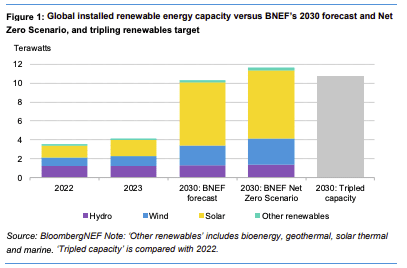The recent report, from Bloomberg New Energy Finance, on tripling renewable energy capacity by 2030 underscores an urgent call to action for the global energy sector. With nearly 200 countries committing to this ambitious target at COP28, the report reveals that substantial investments and innovative solutions are essential to make this vision a reality.
Investment needs are staggering—averaging $1 trillion annually through 2030—to meet both the tripling capacity and net-zero goals.
The push to triple global renewable energy capacity by 2030 presents both exciting opportunities and significant challenges. Two critical elements—solar energy and energy storage—are at the heart of this transition. Here are five key takeaways from the latest report on how these technologies will drive the clean energy revolution:
1. Solar Energy is Growing Faster Than Any Other Renewable Source
The report highlights the rapid growth of solar energy, which is leading the way in renewable capacity expansion. In fact, solar will account for 62% of all new renewable capacity by 2030. This fast-paced development, driven by falling costs and widespread adoption, shows how essential solar is to meeting climate targets.
2. Solar is Key to Emissions Reductions
The report emphasises that solar plays a vital role in cutting global emissions. By displacing fossil fuels, solar energy is responsible for over half of the emissions reductions expected by 2030. This makes the rapid deployment of solar power a key part of any strategy to meet net-zero targets and limit global warming.
3. China Leads the Way in Solar Deployment
China is emerging as a global leader in solar energy, adding massive amounts of capacity each year. Its investments in large-scale solar projects are setting the pace for the world, demonstrating how aggressive policies and infrastructure development can drive significant renewable energy growth.
4. Energy Storage Investments Must Accelerate
The report highlights the critical role of energy storage in supporting renewable energy, especially solar. To fully leverage solar’s potential, an average of $193 billion per year is needed in battery storage investment from 2024 to 2030. This will help store excess energy and ensure a reliable supply, even when the sun isn’t shining.
5. Storage Infrastructure is Lagging Behind Solar
Although solar is expanding quickly, energy storage infrastructure isn’t keeping up. Without sufficient storage, excess solar energy can’t be used effectively, which could lead to grid instability. Scaling up storage solutions like battery systems is essential to maximise solar’s impact and ensure a smooth energy transition.
For businesses looking to integrate solar and battery systems behind-the-meter, these insights are crucial. Solar offers a clear opportunity to reduce energy costs and increase sustainability, but without storage, its impact is limited. By investing in battery storage, businesses can store excess solar energy and use it during peak times, reducing their reliance on the grid and increasing energy resilience. The report makes it clear: combining solar with energy storage behind-the-meter is not just smart—it’s essential for maximising the benefits of renewable energy and securing long-term savings.
As we move forward, the collaboration between technology providers, policymakers, and the private sector will be vital. At Wattstor, we are committed to being at the forefront of this clean energy revolution, delivering solutions that empower industrial and commercial businesses and drive sustainable growth.

